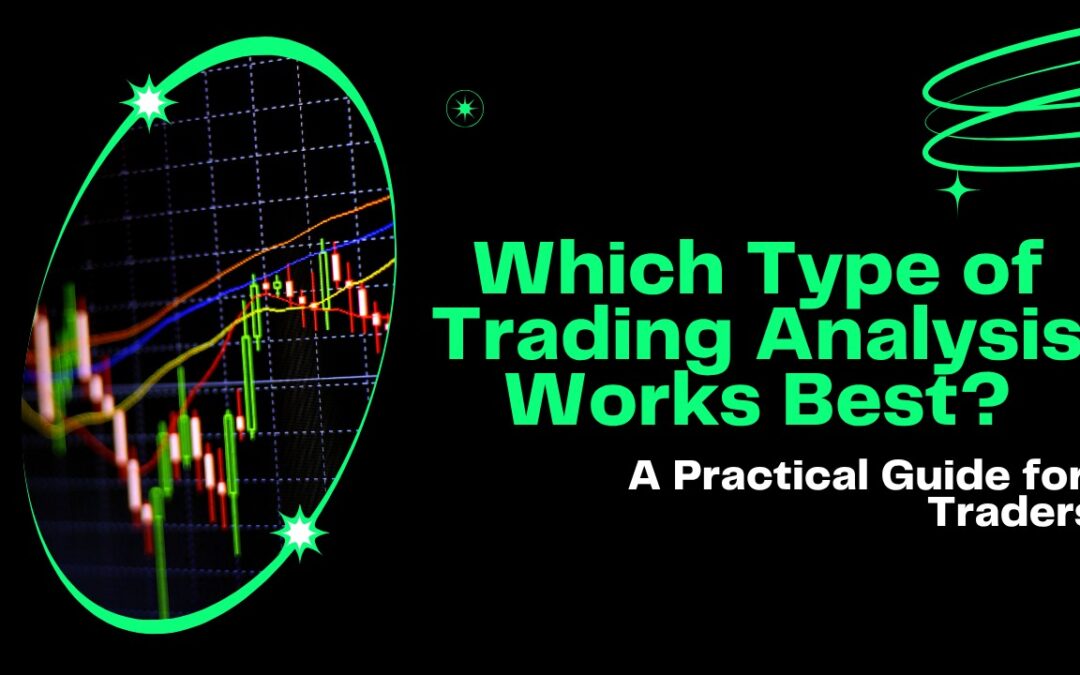Markets do not follow the news. They do not always follow charts either. Sometimes they just do what they want. That’s why traders often argue about which type of analysis actually works. Some trust the charts, others stick to economic data, and many rely only on volume and order flow.
So, which one makes the most sense? Which one gives real signals and not noise? The truth is, it depends. But you can get a lot closer to consistency if you understand what each type offers — and when to use it.
Understanding the Three Main Types of Market Analysis
There are three types most traders use: technical, fundamental, and order flow. Each one focuses on different data and has its own strengths and blind spots. You can use one or combine them. But knowing what they do helps you avoid the traps.
Technical analysis studies price movement. It uses charts, indicators, and patterns. It doesn’t care why something moved — only that it did. Fundamental analysis looks at the reason behind moves. It watches interest rates, inflation, earnings, and news. Order flow analysis focuses on who is buying or selling. It looks inside the candle, not just at the high or low.
If you want tools for each type, trading analysis software like ATAS can help. It shows price, volume, and flow — all in one place.
Technical Analysis: Tools, Signals, and What to Watch
Technical analysis is where many traders start. It’s visual, straightforward, and doesn’t rely on outside events. Instead of watching the news, traders study the chart itself. They try to spot repeatable behavior and areas where the price tends to react.
This method works best when the market respects structure. And it gives clear rules for entries and exits — if applied with discipline.
Key Concepts in Technical Analysis
Technical traders look for patterns. That includes trends, channels, breakouts, and candlestick signals. The goal is to find places where the price might move again. Indicators like the relative strength index (RSI) or moving averages help them confirm what they see.
Support and resistance levels matter most. If the price has reacted to a level several times, it might do so again. That’s where many place their trades.
Some also use Fibonacci retracements, trendlines, and Bollinger Bands. These tools don’t predict; they show where others might react. Many traders now use crypto trading analysis software to layer these indicators in fast-moving markets and spot setups across multiple coins or tokens.

When Technical Analysis Works Best
This approach fits certain conditions more than others. Knowing when it works gives traders better odds.
It is most effective when:
- Markets are active and liquid
- Price shows clear trends or range structures
- News is light, with no major surprises
- Patterns repeat often enough to use for timing
- You’re trading short to medium timeframes.
It doesn’t work well when headlines drive moves. That’s when fundamental or order flow data becomes more reliable. But in stable conditions, patterns and levels give useful signals.
Fundamental Analysis: Looking Beyond the Chart
Fundamental analysis focuses on the “why” behind price movement. While charts show what happened, fundamentals explain the reason. This approach looks at economic data, corporate performance, and news that can shift sentiment or change trends. It’s essential for long-term traders and those who want to understand the forces behind a move.
Macro and Micro Fundamentals
Macro means big picture: interest rates, gross domestic product (GDP), inflation, war, and energy prices. Micro means company-level stuff: earnings, balance sheets, dividends. Together, they move the market.
Currencies and commodities react fast to macro shifts. Stocks react more to company reports. Traders who watch fundamentals look at data releases, speeches, and forecasts. Economic calendars and tools like Koyfin or Finviz help. These show what’s scheduled and how past reports affected the price.
Strengths of Fundamental Analysis
Fundamentals help explain what’s driving price. Instead of guessing, traders can rely on economic and company data to understand market direction. This builds confidence in trade decisions, especially for bigger picture moves.
Here’s where fundamental analysis helps:
- Explains why a trend started, such as oil rising due to supply cuts.
- Gives long-term direction when central banks shift policy or tone.
- Allows traders to anticipate sentiment shifts before they fully unfold.
- Adds a layer of caution when technicals show a setup, but data doesn’t confirm it.
If a central bank signals rate hikes, traders can prepare in advance. If the Fed changes its tone, the dollar might trend for weeks. And if charts suggest a breakout but the economic data is weak, the move could fail. Fundamentals filter those risks.
Many traders now combine this approach with stock trading analysis software, which helps merge technical indicators with economic data for more informed decisions.
Its Limits in Short-Term Trading
The biggest problem is lag. By the time the news hits the chart, the move might be done. Or the market may react differently than expected. Another issue is noise. Not every report matters. It’s easy to get caught up in headlines that don’t move the price.
Lastly, fundamental analysis often lacks the precision of timing; even if you understand the larger economic context, short-term price movements may go against your expectations. To improve timing and execution, traders often turn to technical analysis or order flow analysis, which may help pinpoint better entry and exit points.
Order Flow and Volume-Based Analysis: Real Market Intent
Order flow shows who’s buying and selling. It doesn’t care about patterns or news; it tracks real trades in real time. Volume profile shows where most trades happened at each price. That helps find support and resistance based on real interest.
Footprint charts show how many contracts traded on the bid and ask. You can see where buyers pushed and where sellers held. Delta shows net buying or selling.

Tools like ATAS offer footprint, delta, and volume profile on one screen. That helps you track pressure, see absorption, and spot exhaustion. This method eliminates guesswork and lets you read the flow of the market.
It’s especially effective for intraday or short-term trades and works best in active markets. Many prop traders and scalpers rely on it for precise execution.
Why ATAS Stands Out for Volume and Flow Traders
ATAS offers unique insights into market activity by showing what’s happening inside each candle. Traders can view footprint charts with bid/ask splits, check delta to track pressure shifts, and use volume profile overlays. You can draw profiles for any range — session, hour, or custom time — and filter by aggressive buyers or sellers.
The trading analytics platform also features a replay mode, which allows you to train and test ideas. You can set up alerts for when the price reaches value area highs or lows. Combining footprint charts with classic candlesticks provides both context and precision for better trading decisions.
To better understand how ATAS compares with typical charting software, here’s a quick feature breakdown:
| Feature | ATAS | Typical Charting Software |
| Footprint Charts | Yes | No |
| Volume Profile Tools | Advanced | Basic or none |
| Delta/Imbalance View | Yes | Limites or no |
| Replay and Simulation | Full | Limited |
| Custom Alerts on Volume Zones | Yes | No |
ATAS doesn’t just show price — it shows behavior. You can see where traders are pushing, where they’re pulling back, and when momentum shifts. This is what sets it apart from basic platforms. Instead of guessing based on patterns alone, you get real data about pressure and intent. That helps you trade with more clarity and less hesitation.
How Traders Combine Analysis Types in Practice
Scenario 1: Technical + Order Flow
A trader sees a resistance zone on the chart. Price comes close. On the footprint chart, red delta stacks up. Sellers dominate the ask. That confirms the zone is holding. The trader places a short with a tight stop. They don’t just rely on the technical level alone; they confirm the market’s behavior by analyzing who is active at that price.
Scenario 2: Macro View + Technical Timing
The Fed signals a possible rate hike. The trader expects the dollar to rise. But they wait for a clean break of resistance on the chart before entering. That way, they get both the context and the timing right. Fundamentals set the direction, while technicals provide the entry point.
Scenario 3: Volume Profile + Delta Shifts
Price enters a High Volume Node. That’s where many positions sit. The footprint shows delta flipping from buy to sell, which indicates that buyers are being absorbed. That’s a signal the level might reject. The trader takes the reversal trade and uses volume to identify the area and delta to confirm market intent.
What Really Matters: Context Over Complexity
Traders often chase signals by adding more indicators, following alerts, and keeping an eye on news feeds. But this rarely improves their trading results.
What truly works — and what the greatest traders excel at — is keeping things simple. Focus on context. Ask yourself: where are we in the bigger picture? What’s the volume doing? Who’s active at this level?
Even with advanced technical analysis trading software, the edge comes from understanding structure and flow — not from cluttering your screen with tools.
Instead of adding more indicators, here’s what to focus on:
- Clear support or resistance from volume
- Footprint confirmation near key levels
- Clean value area rejection or acceptance
- Delta divergence at turning points.
The best trades often come from one clean level and one solid confirmation. That could be a delta spike, a failed test, or a breakout with strong volume. Fewer, well-interpreted signals provide greater clarity.
Conclusion: There’s No One-Size-Fits-All

Some traders love news, others block it out. Some stare at charts all day, others trade one level a week. What works best depends on your style. If you need structure, use technicals. If you trade news or long-term trends, use fundamentals. If you want precision, learn order flow.
The best setups often come from mixing them. A chart level with strong volume and clear order flow gives more edge than any one tool. The software you use matters too. Platforms like ATAS — often ranked among the best trading analysis software — let you see the real story behind the chart. However, the real skill lies in how you read the market and not how many indicators you use.






